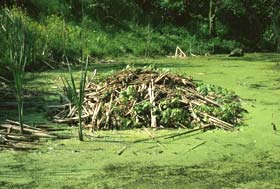Background Information:
What is a habitat? A habitat is the environment in which a specific
organism lives. It is a place that supplies the organism with its essentials
for survival – food, water, shelter, and space. Think of it as an animal’s
address. A fish’s habitat may be a weed bed at the bottom of a lake. A
tree’s habitat may be one small area of a forest. A beetle’s habitat may
be a rotten log. Within an animal’s habitat the four essentials are equally
important and must be available in a suitable arrangement. A deer could live
in a park that has water, shelter, and plenty of space to roam around but if
there is little food it won’t be able to survive.
How is a habitat different than an ecosystem? Good question!
One organism defines a habitat. An ecosystem is defined by a variety of
organisms interacting together. A small area of the prairie can be the habitat
in which a prairie coneflower lives while the entire prairie is an ecosystem
where many animals live and interact with each other and the nonliving things
around them.

Here is an example of a muskrat’s habitat.
(I got this information from www.enature.com.)
The muskrat’s habitat can be found in marshes, ponds, lakes, rivers, and
canals. The essentials the muskrat needs in its habitat are…
 Food:
The muskrat eats mostly aquatic plants, such as cattails, sedges, rushes,
water lilies, and pond weeds, along with some terrestrial plants. In some
areas, the muskrat eats freshwater clams, crayfish, frogs, and fish.
Food:
The muskrat eats mostly aquatic plants, such as cattails, sedges, rushes,
water lilies, and pond weeds, along with some terrestrial plants. In some
areas, the muskrat eats freshwater clams, crayfish, frogs, and fish.
Water: The muskrat lives in an aquatic environment so there is
plenty of water available.
Shelter: The muskrat will build a lodge to live in. Sometimes rather
than build a house, the muskrat burrows into the bank along the water’s edge
and constructs a bank den with several entrances.
Space: The muskrat needs enough space in their water habitat to find
food, build a lodge, and raise a family.

Now download your field notebook and do the activities as indicated.

Back to Clue 3